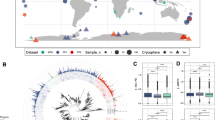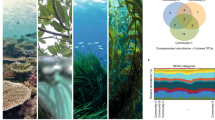Abstract
The signs of climate change are undeniable, and the inevitable impact for Earth and all its inhabitants is a serious concern. Ice is melting, sea levels are rising, biodiversity is declining, precipitation has increased, atmospheric levels of carbon dioxide and greenhouse gases are alarmingly high, and extreme weather conditions are becoming increasingly common. But what role do microorganisms have in this global challenge? In this Viewpoint article, several experts in the field discuss the microbial contributions to climate change and consider the effects of global warming, extreme weather, flooding and other consequences of climate change on microbial communities in the ocean and soil, on host–microbiota interactions and on the global burden of infectious diseases and ecosystem processes, and they explore open questions and research needs.
This is a preview of subscription content, access via your institution
Access options
Access Nature and 54 other Nature Portfolio journals
Get Nature+, our best-value online-access subscription
$29.99 / 30 days
cancel any time
Subscribe to this journal
Receive 12 print issues and online access
$209.00 per year
only $17.42 per issue
Buy this article
- Purchase on Springer Link
- Instant access to full article PDF
Prices may be subject to local taxes which are calculated during checkout
Similar content being viewed by others
References
Hutchins, D. A. & Fu, F. X. Microorganisms and ocean global change. Nat. Microbiol. 2, 17508 (2017).
Boyd, P. W. et al. Experimental strategies to assess the biological ramifications of multiple drivers of global ocean change. Glob. Change Biol. 24, 2239–2261 (2018).
Jansson, J. K. & Tas, N. The microbial ecology of permafrost. Nat. Rev. Microbiol. 12, 414–425 (2014).
Tas, N. et al. Landscape topography structures the soil microbiome in arctic polygonal tundra. Nat. Commun. 9, 777 (2018).
Christensen, T. R. et al. Thawing sub-arctic permafrost: effects on vegetation and methane emissions. Geophys. Res. Lett. 31, L04501 (2004).
Hodgkins, S. B. et al. Changes in peat chemistry associated with permafrost thaw increase greenhouse gas production. Proc. Natl Acad. Sci. USA 111, 5819–5824 (2014).
Woodcroft, B. J. et al. Genome-centric view of carbon processing in thawing permafrost. Nature 560, 49–54 (2018).
Singleton, C. M. et al. Methanotrophy across a natural permafrost thaw environment. ISME J. 12, 2544–2558 (2018).
McCalley, C. K. et al. Methane dynamics regulated by microbial community response to permafrost thaw. Nature 514, 478–481 (2014).
Emerson, J. B. et al. Host-linked soil viral ecology along a permafrost thaw gradient. Nat. Microbiol. 3, 870–880 (2018).
Wik, M. et al. Multiyear measurements of ebullitive methane flux from three subarctic lakes. J. Geophys. Res. Biogeosci. 118, 1307–1321 (2013).
Singh, B. K. et al. Microorganisms and climate change: feedbacks and mitigation options. Nat. Rev. Microbiol. 8, 779–790 (2010).
Maestre, F. T. et al. Increasing aridity reduces soil microbial diversity and abundance in global drylands. Proc. Natl Acad. Sci. USA 12, 15684–15689 (2015).
Sheik, C. S. et al. Effects of warming and drought on grassland microbial communities. ISME J. 5, 1692–1700 (2011).
Delgado-Baquerizo, M. et al. Microbial diversity drives multifunctionality in terrestrial ecosystems. Nat. Commun. 7, e10541 (2016).
Delgado-Baquerizo, M. et al. Soil microbial community drives resistance of ecosystem multifunctionality to global change in dryland across the globe. Ecol. Lett. 20, 1295–1305 (2017).
Karhu, K. et al. Temperature sensitivity of soil respiration rates enhanced by microbial community response. Nature 513, 81–84 (2014).
Hutchins, D. A. & Boyd, P. W. Marine phytoplankton and the changing ocean iron cycle. Nat. Clim. Chang. 6, 1071–1079 (2016).
Wubs, E. R. J. et al. Soil inoculation steers restoration of terrestrial ecosystems. Nat. Plants 2, 16107 (2016).
Maestre, F., Sole, R. & Singh, B. K. Microbial biotechnology as a tool to restore degraded drylands. Microb. Biotechnol. 10, 1250–1253 (2017).
Hu, H. W. et al. Microbial nitrous oxide emissions in dryland ecosystems: mechanisms, microbiome and mitigation. Environ. Microbiol. 19, 4808–4828 (2017).
Mellby, B. L. et al. Quorum quenching of Nitrogbacter winogradskyi suggests that quorum sensing regulates of nitrogen oxide(s) during nitrification. mBio 7, e01753–16 (2016).
Jansson, J. K. & Hofmockel, K. S. The soil microbiome — from metagenomics to metaphenomics. Curr. Opin. Microbiol. 43, 162–168 (2018).
Angle, J. C. et al. Methanogenesis in oxygenated soils is a substantial fraction of wetland methane emissions. Nat. Commun. 8, 1567 (2017).
Author information
Authors and Affiliations
Corresponding authors
Ethics declarations
Competing interests
The authors declare no competing interests.
Additional information
Publisher’s note
Springer Nature remains neutral with regard to jurisdictional claims in published maps and institutional affiliations.
Rights and permissions
About this article
Cite this article
Hutchins, D.A., Jansson, J.K., Remais, J.V. et al. Climate change microbiology — problems and perspectives. Nat Rev Microbiol 17, 391–396 (2019). https://doi.org/10.1038/s41579-019-0178-5
Published:
Issue Date:
DOI: https://doi.org/10.1038/s41579-019-0178-5
This article is cited by
-
Gut microbiota modulation enhances the immune capacity of lizards under climate warming
Microbiome (2024)
-
Genetic toolbox for Photorhabdus and Xenorhabdus: pSEVA based heterologous expression systems and CRISPR/Cpf1 based genome editing for rapid natural product profiling
Microbial Cell Factories (2024)
-
Soil microbial diversity plays an important role in resisting and restoring degraded ecosystems
Plant and Soil (2024)
-
Prokaryotic communities of the French Polynesian sponge Dactylospongia metachromia display a site-specific and stable diversity during an aquaculture trial
Antonie van Leeuwenhoek (2024)
-
Loss in the rare bacterial diversity drives the monocropping obstacle of cut chrysanthemum
Journal of Soil Science and Plant Nutrition (2024)



